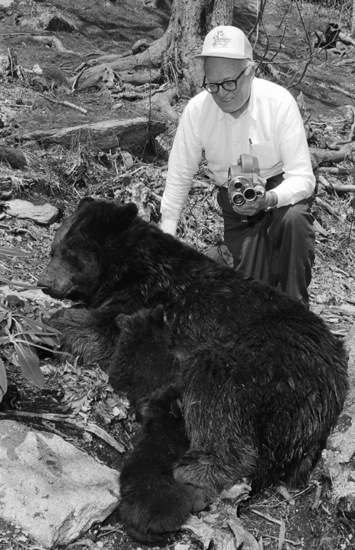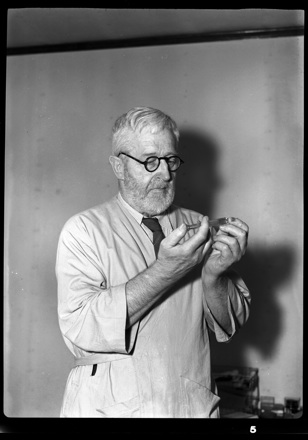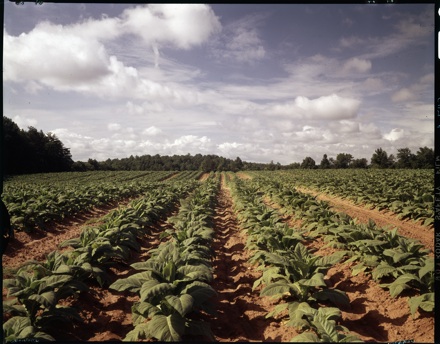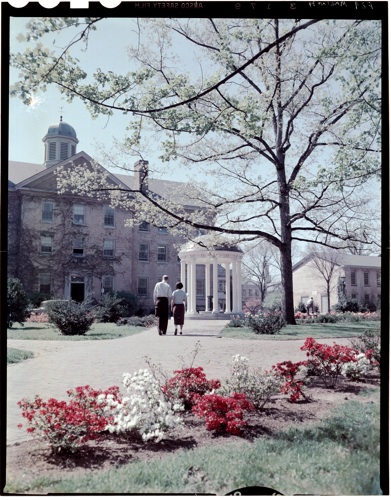
Here in Chapel Hill, the daffodils are blooming, the world is mud-luscious, and the sweet sound of sneezing floats on the breeze. It must be spring!
As the buds begin to blossom, so too does the tourist season in North Carolina. To provide some perspective on the development of the tourism industry in the Old North State (and Hugh Morton’s role in it), we offer our newest essay in the Worth 1,000 Words series: Selling North Carolina, One Image at a Time, by Richard Starnes.
Starnes is an historian specializing in southern history and Appalachia, Associate Professor and History Department Chair at Western Carolina University, and author of the 2005 book Creating the Land of the Sky: Tourism and Society in Western North Carolina.
Read, share, discuss, and enjoy.
Elizabeth Hull
March Madness (on V2H, at least)
 Let’s face it — us fans of Tar Heel men’s basketball need something to distract us from the season currently underway.
Let’s face it — us fans of Tar Heel men’s basketball need something to distract us from the season currently underway.
Since we’re unlikely to experience any actual March Madness this year, we’ll have to create our own on “A View to Hugh.”
How about a refresher course in Carolina basketball glories past, courtesy Art Chansky and Hugh Morton? That’s right, our latest Worth 1,000 Words essay, entitled The Tar Heels’ ‘White House Photographer’ is now available!
Chansky, well-known as the chief chronicler of Carolina Basketball, is the author of such books as March To the Top (1982), Return To the Top (1983), and his latest, entitled Light Blue Reign: How a City Slicker, a Quiet Kansan, and a Mountain Man Built College Basketball’s Longest-lasting Dynasty (2009). We’re thrilled to have him as part of Worth 1,000 Words.
We hope our latest essay makes you fans feel a bit better . . . while Coach Smith and James Worthy might look upset in the above photo, they’d actually just won the national championship! It’s only a matter of time before the Heels are “on top” once again.
A View or Two of Hugh
Note from Elizabeth: In honor of what would have been Hugh Morton’s 89th birthday today, Morton collection volunteer Jack Hilliard wanted to offer this tribute to Morton’s life and work.
Hugh Morton has been called the dean of North Carolina photographers. During his career he photographed 11 Presidents of the United States, the Queen of England, the future King of England, dozens of governors, senators, congressional representatives, generals, movie stars and ordinary folks. His work appeared in national magazines…Life, Time, Newsweek, National Geographic, Reader’s Digest, and Collier’s.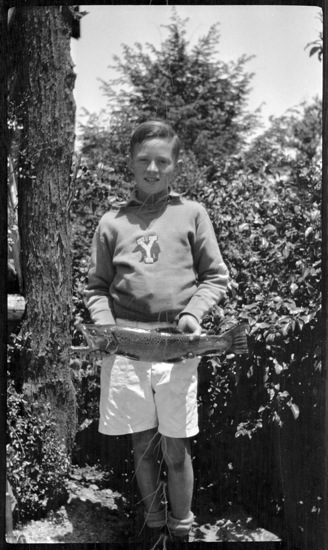
For almost 70 years he was a fixture on the sidelines of Kenan Stadium and courtside at Woollen, Carmichael, and the Smith Center. From Justice to Jordan . . . McKinney to McCauley . . . Weiner to Worthy . . . he was there and he photographed what he saw. His sports photography can be found on magazine covers, post cards, calendars, bubblegum cards, the facade in the west end of Kenan Stadium, and tabletops in Lenoir Hall. His classic shot of Charlie Justice leaving the field at Kenan for the final time has “become” a statue on the UNC Campus. That list could go on.
Along the way he photographed the Sugar Bowl, the Cotton Bowl, the World Series, the Final Four and the Kentucky Derby, as well as Democratic National Conventions and NASA space shots.
His photographs of Ted Williams, Mickey Mantle, Arnold Palmer, Mia Hamm, Bill Dudley, Catfish Hunter, Billy Joe Patton, and Dale Earnhardt are just part of his sports portfolio. That list could go on as well.
Dr. William Friday introduced Hugh Morton at a Charlotte gathering of UNC alumni and friends in November of 2004 as “a man who can move battleships, make Grandfather Mountain the greatest attraction in the world . . . (and) defy the federal government and build a viaduct around the mountain.” The May-June, 1941 issue of Carolina Magazine called him “Rembrandt with a camera.” CBS News Correspondent Charles Kuralt once compared his work to that of Van Gogh.
The manner in which Hugh Morton lived his life defined the term “public service.” Again, in the eloquent words of Dr. William Friday;
“His good works were many, and the great joy of his life, after his family, was his camera and those thousands of moments he captured that help us all define ourselves and our great state and nation. He was a true patriot.”
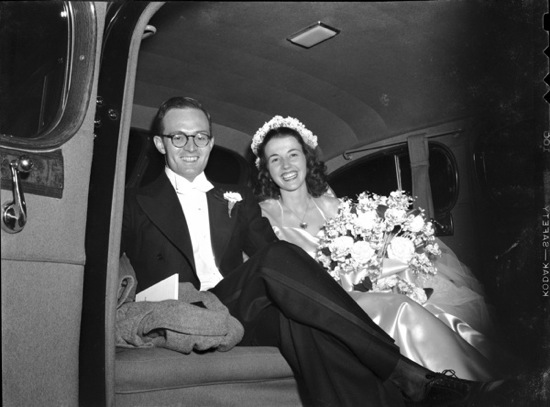 Hugh Morton’s place in history is secure and I choose to believe he is looking down on us today, his 89th birthday, as we work with the photographs and films that have become his legacy. So, if I may, let me close with Dr. Friday’s words from June 9, 2006 as he concluded his eulogy at Hugh’s memorial service at First Presbyterian Church in Greensboro.
Hugh Morton’s place in history is secure and I choose to believe he is looking down on us today, his 89th birthday, as we work with the photographs and films that have become his legacy. So, if I may, let me close with Dr. Friday’s words from June 9, 2006 as he concluded his eulogy at Hugh’s memorial service at First Presbyterian Church in Greensboro.
“We shall remember, old friend, we shall always remember.”
— Jack Hilliard
New essay, new look
 First and foremost, we’re thrilled to announce the availability of the second essay in our Worth 1,000 Words series: it’s by former University Archivist Janis Holder and is entitled Covering the Beat: The University in the WWII Era. Please read, enjoy, share, and comment!
First and foremost, we’re thrilled to announce the availability of the second essay in our Worth 1,000 Words series: it’s by former University Archivist Janis Holder and is entitled Covering the Beat: The University in the WWII Era. Please read, enjoy, share, and comment!
Secondly, you may have noticed that “A View to Hugh” has gotten a bit of a makeover! We’ve upgraded to a new “theme” in WordPress, but tried to maintain much of the original look, feel and functionality. The most pressing reason for this upgrade was to better accommodate our essays, which you will see now occupy their own section of the V2H website. The essays are now posted as their own pages, rather than as traditional posts.
For those of you who might be missing the old V2H look, you should also know that our original WordPress theme was “orphaned” and had become out-of-date and cumbersome to use. Our new theme is sleeker, much more functional, and allows for larger images and neat widgets like the new Digital Collection RSS feed in the right sidebar, which allows you to peruse recent additions to the ever-expanding Hugh Morton Digital Collection. It was time for a change, and we hope you find it one for the better.
An ongoing "miracle in the hills"
A few weeks ago I received a friendly call from Mr. Bob Martin, an Avery County resident, author, admirer of Hugh Morton, and former director of the Crossnore School, a private, non-profit home and school in the NC mountains serving (primarily) abused and neglected children. Bob’s call triggered a memory of a set of Morton images that had caught my interest a while back—two circa 1940s portraits of Dr. Eustace H. Sloop, co-founder (with his wife Mary Martin Sloop) of the Crossnore School.
While perhaps not the most aesthetically pleasing example of Morton’s work, I like these Sloop portraits because they show him engaged in his primary calling, medicine. Both Eustace and his wife Mary were trained as doctors, and arrived in Crossnore in 1913 planning to provide much-needed medical assistance in the Appalachian Mountains. Mary soon devoted herself to improving public education as well, founding the live-in school in 1917; it was re-incorporated in 1939 as “a child-caring institution, whose purpose shall be to provide a home and industrial and vocational training for orphan, half-orphan, and deserted children . . . preference being given to mountain children” (from p. 8 of Philis Alvic’s 1998 history, The Weaving Room of Crossnore School).
You can learn about Mary T. Martin Sloop’s remarkable life through her 1953 memoir Miracle in the Hills: The lively personal story of a woman doctor’s forty-year crusade in the mountains of North Carolina, written with LeGette Blythe. As Blythe described Sloop, “no mold shaped her, no die stamped her out. . . . She is one of our last examples of the sturdy, energetic pioneer women who played such an important role in the settling of America.”
I wish I had more illustrative material for this post, e.g. a portrait of Mary Sloop — but Morton doesn’t seem to have taken any. Bayard Wootten, however, did; she took this shot of the Sloops performing surgery in the field, circa 1917. (It was included in a 2005 exhibit put on by the North Carolina Collection Gallery entitled “Sour Stomachs, Galloping Headaches,” along with a few other early images from the Crossnore School, including Wootten’s photograph of outdoor surgery.)
Series 3 (Nature & Scenic) available!
Just a quick note to let you know that Series 3, and all the gorgeous, meditative splendor contained therein, is now available and included in the online finding aid for the Morton collection. (Note that the URL for the finding aid has changed, but the old link will redirect you to the new one). Note also that this is the first series to include 35mm slides in its inventory (we’re working on adding the slides for Series 1 & 2 retrospectively). Enjoy!
Morton Among the Movers and Shakers
Note from Elizabeth: I’m pleased to present the very first essay from Worth 1,000 Words project, written by journalist Rob Christensen. Rob has been writing about N.C. politics as a reporter and a columnist for 36 years for The News and Observer and The Charlotte Observer; his book The Paradox of Tar Heel Politics won the N.C. Literary and Historical Association’s Ragan Old North State Award for the best work of nonfiction in 2008.
Update 2/9/10: This post has now been converted into its own “page” under the Essays section of A View to Hugh.
Digital collection at 3,000+ items!
We’ve been particularly active over the past few weeks adding images to the Hugh Morton Digital Collection, which now contains more than 3,000 items. The influx is due to the fact that 1) our new digitization assistant Sam Leonard has really hit the ground running, and 2) we’ve started scanning 35mm slides in earnest. (Slides go a bit faster due to automated scanning and because we’re often able to cut-and-paste a lot of the descriptive information).
Many of the most recent additions, including the beautifully-composed image above, have been from Morton’s nature photography. (Speaking of which, processing on Series 3, Nature & Scenic, is now finished — so be on the lookout for a major addition to the Morton finding aid in the near future). We’re adding new items every day, but as of this moment the digital collection can be browsed by 419 different names, 253 different locations, and (whoa!) 951 different subjects.
Just wanted to remind you of this remarkably varied and ever-growing resource, and to encourage you, as always, to give us your feedback on the images and on the work we’re doing.
Up in smoke?
Note from Elizabeth: I hope you’ll join me in welcoming the newest addition to the Morton team, Samantha Leonard! Sam is a Greensboro native in her first year of the grad program at UNC’s School of Information and Library Science, and is serving as our new digitization assistant (replacing David Meincke, who had the gall to move to California). This is Sam’s first post for V2H.
Since I started working for the Hugh Morton Collection in mid-December, I have been bombarded with many amazing images. When Elizabeth asked me to write my first blog post for A View to Hugh, I was somewhat overwhelmed by the choices. To narrow it down, I tried to think of current events. Recently, I scanned a group of negatives of various tobacco settings in North Carolina, and I immediately thought of the smoking ban for NC restaurants and bars that took effect on January 1st of this year.
North Carolina is the country’s leading tobacco producer and has a long history with the crop; this recent ban has been met both with praise and resistance. According to an article by Gary D. Robertson, North Carolina is the 29th state to prohibit smoking in restaurants and the 24th state to prohibit smoking in bars, making it the first of the “tobacco states” to ban smoking in public restaurants and bars.
To understand what a big deal this is for North Carolina and why it is relevant to the Morton Collection is to know that tobacco was one of the state’s main industries while Morton was taking the bulk of his photographs. But the times are changing, with North Carolina shifting to a more services-and-technology state. Robertson writes in his article:
“In 1978, tobacco accounted for 34 percent of all farm income in North Carolina, or $1.1 billion. Thirty years later tobacco production fell to $687 million, or only 7 percent of farm income, according to federal agricultural data. The amount of tobacco grown also fell during the same period from about 850 million pounds to 390 million pounds.”
So to honor this shift in North Carolina’s history and economy, I thought it would be fitting to look at a few of Morton’s striking tobacco images:
These photographs were taken in NC tobacco fields during the 1940s to early 1950s. I thought that the first picture was interesting because this man is smoking a cigarette while working in a tobacco field; I like the second one because it shows children, adults, and both whites and blacks working together in the fields. I like to think Morton is showing us how deeply ingrained tobacco is in his subjects’ lives, whether it be through farming, pleasure, or family.
Continue reading “Up in smoke?”
Grandfather State Park closed indefinitely
You may have heard the news this morning about Grandfather Mountain State Park being closed to visitors indefinitely due to dangers caused by recent accumulations of snow, ice, and fallen trees/limbs. I experienced some of those weather adventures first-hand over the holidays in Boone, where a Christmas Eve ice storm caused extensive treachery and knocked out power to about 21,000 (it was out at my parents’ house for five days).
We wish all the best to Grandfather staff in getting the park up and running again. It sounds like they’ve all really banded together in response to these “weather challenges.” I wonder how many times, and for how long, Grandfather has had to close due to weather in the past? Speaking for myself, I have no interest in traversing the Mile High Swinging Bridge in conditions like those shown below. Brrr.
UPDATE 1/8/09: To clarify: only Grandfather Mountain State Park is closed indefinitely; the Grandfather Mountain attraction (the Mile High Swinging Bridge, animal habitats etc.) has not made the to close indefinitely. Whether the travel attraction will be open will be a day-to-day decision. For the time being, visitors should call (828) 733-2013 before making plans to travel to Grandfather.

